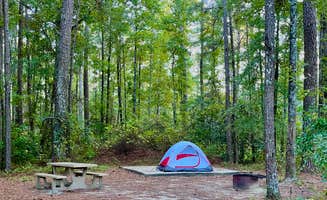Congaree National Park sits within a floodplain ecosystem containing one of the tallest deciduous forest canopies remaining in North America. The park's tent campsites near Columbia, South Carolina feature trees averaging over 100 feet tall, with some reaching 160 feet. The lowland terrain experiences periodic flooding throughout the year, particularly during winter and early spring when water levels can rise several feet above normal.
What to do
Observe synchronous fireflies: During late May to early June, visitors can witness the rare phenomenon of synchronous fireflies. One camper at Longleaf Campground noted, "The fireflies were very pretty and interesting. We saw other wildlife around the campground too."
Night sounds experience: The wetland environment creates a unique soundscape after dark. A reviewer mentioned, "The campground is next to a pond that gets rather loud at night. I never knew frogs/toads could be so loud." This natural concert provides an immersive wilderness experience.
Hike boardwalk trails: The elevated boardwalk system allows exploration of the floodplain even during wet conditions. A visitor at Longleaf stated, "Easy walk to visitor center from campground. On the path after crossing the road, we saw the synchronous fireflies!"
What campers like
Site spacing and atmosphere: The campgrounds offer adequate separation between sites. According to one Longleaf camper, "Sites were spread out, but also the vibe was less 'party all night' and more 'sleep and then explore the park during the day.' Exactly my kind of vibe!"
Accessible first sites: For those who prefer minimal hiking with gear, certain sites provide easier access. One visitor remarked, "Sites 1-3 are the easiest to get to. We were at site 7, it took about 250 steps from the parking lot to our site."
Diverse wildlife viewing: Beyond the fireflies, the area supports numerous species. A camper observed, "A lizard during a walk during the day. Many frogs during the rain at night." Bird watching opportunities abound throughout the park.
What you should know
Water management challenges: The campground's location makes it susceptible to flooding. A Longleaf visitor shared, "The first night got a lot of rain and storms and several of the campers from sites farther back left saying they were flooded out. Our site did have some water during the storm but it was gone by morning."
Transport gear challenges: Plan for carrying all equipment from parking areas. One camper suggested, "Definitely bring a wagon for packing your stuff in," while another noted, "If I did [bring everything], it would be nice to have a second person or a wagon."
Nearby supplies: Basic provisions are available within a short drive. A visitor mentioned, "There is a convenience store with sandwiches, ice, beer, and groceries in Gadsden 8 min away which was convenient."
Insect preparation: The wetland ecosystem supports abundant insect life, particularly during warmer months. A recent visitor warned simply, "Lots of bugs so come prepared."
Tips for camping with families
Site selection for children: When camping with kids, choosing the right site matters. A visitor to Blythewood Acres noted the "level sites" which can be advantageous for setting up family-sized tents and creating safe play areas.
Heat consideration: Summer temperatures can be challenging with children. One camper shared, "The heat in June is also pretty bad, so having to go back and forth out to your vehicle to bring your stuff in and out is very difficult even though the path is flat and very short."
Educational opportunities: The park offers exceptional learning experiences about floodplain ecosystems. A visitor described it as "pristine, but organized trails near the Congaree river and Swamp. Lots of wildlife and ancient trees on the trails."
Tips from RVers
Limited RV options: Traditional RV camping is extremely limited near the national park. For RVers seeking full hookups near Columbia, alternatives are necessary. As one Bluff Hike In Campground visitor discovered, the park's focus is primarily on tent camping experiences.
Cell service considerations: For those needing to stay connected, service varies by location and carrier. One camper reported, "We had Verizon service. Enough to use Google image search to look up plants, animals, and mushrooms we had found."
Security awareness: Some tent camping areas are remote and secluded. One visitor recounted security concerns, though noted, "I appreciated how responsive the rangers were regarding our concern."


